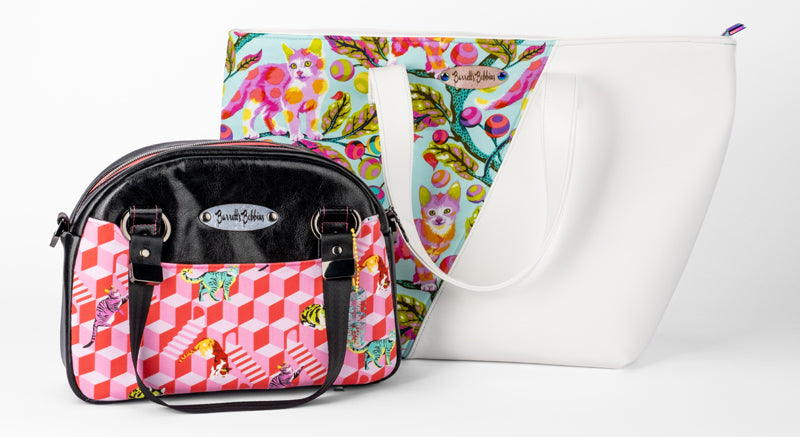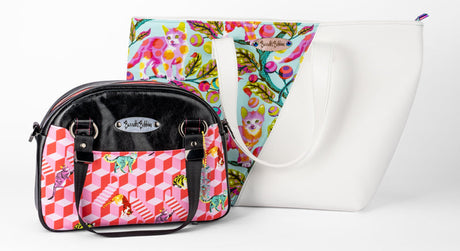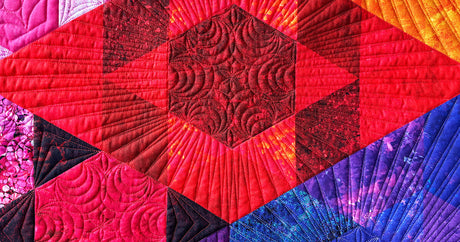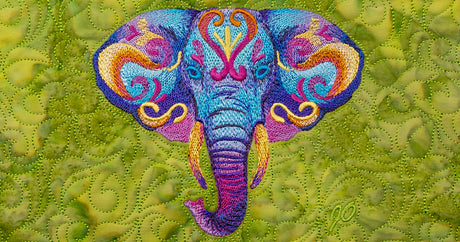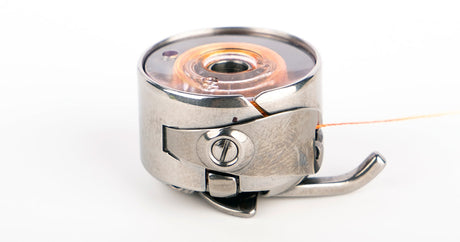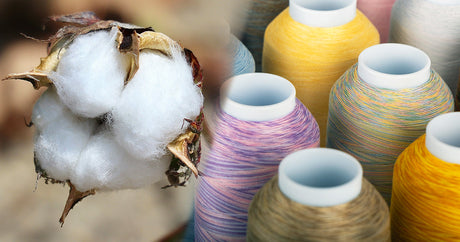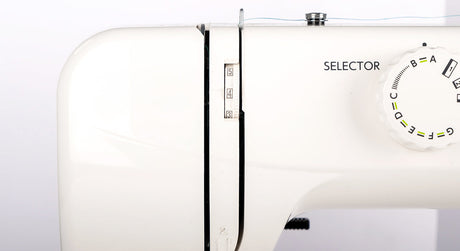Strength and Style in Every Stitch
We love celebrating sewists and quilters who turn their hobbies into art, functional goods, businesses, boutiques, and more. Barrett Hale is one of these sewists. She is known for her beautifully crafted and durable handbags made from eye-catching fabrics, faux leather, and polished metal accents. She combines artistry with engineering in her work. If you ask her why her bags not only look great but are also functional and made from high-quality materials, you'll learn that her secret isn't just in her fabric choices or design. It's also in the thread that holds everything together.
For Barrett, and many sewists who care about creating high-quality goods, quality materials are non-negotiable. She chooses to use YLI's threads in her bags because of their consistency, strength, and balanced stitches. "I've tried many brands of thread over the years, but YLI is the one I trust. It handles thick layers of fabric and vinyl without fraying or breaking, and it always produces smooth, even stitches."

We love the colorful cat print and white vinyl blend.
Why Thread Choice Matters for Bag Makers
Sewing and constructing bags, purses, carryalls, etc., follows a different process than making quilts or clothing. The materials are usually heavier and thicker, which puts more strain on the seams. If you've ever bought a bag where the seams fell apart too soon, you've experienced the result of poor-quality thread, materials, and/or craftsmanship. Thread choice can significantly affect the quality of the finished sewn product. Strong, durable seams that can withstand daily use make the difference between a bag that lasts and one that frays, piles, or falls apart too quickly.
Barrett explained that she chooses polyester sewing thread because it provides the reliability she needs. "I use cotton for quilts, but when I'm sewing a bag, I reach for polyester every time," she said. "In my experience, a filament or corespun polyester thread is strong, smooth, and holds its shape, even under high tension."
High-tensile strength (also known as breaking strength) is what sets our Perfection and QuiltMaker threads apart. Both of these thread collections stitch extremely well under pressure while delivering the beauty and finesse that experienced sewists expect.
Stitching Smoothly with Perfection
Barrett often starts her projects with Perfection, our smooth 50 wt. polyester sewing and quilting thread. Made for high-speed stitching on both home and longarm machines, it has a soft, matte finish that blends beautifully with fabric.
What makes Perfection special is its construction. This multifilament polyester thread consists of many fine, continuous filaments twisted together. The result is a strong, highly flexible, and smooth thread. Perfection is unique, with a gentle texture that securely grips fabric with each stitch, helping to sew evenly without shifting or bunching—an essential feature for structured designs like bags and purses.
"Perfection glides smoothly through fabric and vinyl without snagging," Barrett explained. "Because of its slight texture, it gives me better control. My seams stay flat, and my stitches look clean and balanced." That texture also helps with stitch formation. The fine fibers interlock neatly, creating a stable, consistent seam that resists unraveling. And because it's lint-free, Perfection helps keep machines cleaner and running smoothly, which quilters and sewists appreciate during long hours at their machines.
What are Multifilament Polyester Threads?
Many sewists are rediscovering the advantages of polyester sewing threads, thanks to recent technological advancements. Multifilament polyester threads are designed for precision, producing no lint, creating flat seams, and offering high tensile (breaking) strength. Each filament, thinner than a human hair, contributes to the thread's overall strength when twisted together, resulting in a stitch-ready thread that withstands high-speed stitching without breaking or fraying.
Unlike spun polyester, which is made from short fibers called staples that are twisted together, multifilament polyester has a continuous, smooth structure. The lack of fuzz reduces friction in the needle and mitigates snags and pulls while stitching. In bag making, where multiple layers of canvas, interfacing, or heavy materials like faux leather come together, the difference in quality is significant.

Using a thread stand for optimal thread delivery.

Colorful prints provide a stark contrast to white vinyl.
Strength with Character: QuiltMaker for Visible Stitching
QuiltMaker is a poly-wrapped poly core thread, meaning it has a smooth filament polyester core surrounded by a layer of spun polyester fibers. This unique combination gives QuiltMaker the strength and stretch of a filament thread with the softness, natural feel, and matte finish of spun polyester. The result is a thread that is both tough and touchable.
"I use QuiltMaker when I want the stitches to stand out," Barrett said. "It has a subtle sheen and just enough texture to show off the stitch pattern. I love that it runs smoothly through my machine, even when I'm sewing through thick interfacing or layered handles."
QuiltMaker is a 40 wt. thread that is slightly heavier than Perfection, which is a 50 wt. thread. This weight difference creates a visible topstitch that adds depth and texture to the stitched design, whether it's a straight stitch or decorative motif. Like all YLI threads, QuiltMaker is colorfast, meaning it won't leach color when washed. It also has high abrasion resistance, ensuring that decorative stitches and seams stay looking their best even after extended use.

Fun details, like this cute "Made with love and pet hair" tag, add personality to the bag.
The Art of Color Matching
Color choice is vital when Barrett selects materials, fabrics, accessories, and thread for her bags. She often uses thread to complement rather than compete with her fabrics.
When a thicker thread or color contrast is needed, QuiltMaker is an excellent option. Its slightly heavier weight (40 wt. thread) enables the color to stand out and be more visible against the fabric, while maintaining a subtle matte finish and avoiding harsh hues. With over 80 colors of QuiltMaker available, Barrett can find the perfect hue or shade for any palette, from neutral linen tones to jewel-toned vinyls.
With finer threads like Perfection, she can be more creative with color. Even if the shade isn't an exact match, the thread blends well because it's finer and has a matte finish. Most sewists consider thread color an essential part of the design, not just a finishing touch. Whether it's outlining a shape, adding texture, or blending into the background, the right thread can subtly or boldly enhance a project.


Tension, Needles, and Machine Tips
Even the best thread needs a proper setup to excel. Barrett uses our Titanium-coated Topstitch needles, typically a size #80/12 for Perfection and #90/14 for QuiltMaker. These needles have a larger eye and deeper groove to protect the thread, preventing friction and fraying.
For tension, she recommends starting with the setting that has worked best for you. It might be 3.5 or 5.0, depending on your machine and materials. Begin where you're comfortable and make slight adjustments as needed. "Every material behaves differently," she said. "I always test a small sample first. Once the stitches look balanced, I know I'm ready to sew." For more information on adjusting tension, read our in-depth educational article Balanced Tension for Quilters.
She also recommends cleaning the bobbin area regularly, especially when switching between fabrics and threads that produce lint, or when using adhesive stabilizers. "A clean machine makes all the difference," she added.
Building Bags That Last
Barrett's dedication to quality and artistry shines throughout her process. From selecting fabrics and materials to choosing stabilizers, buttons, straps, and the right thread for custom bags and purses, her goal is clear: durability without sacrificing beauty. "People might not notice the thread right away, but they notice how the bag feels," she said. "When seams stay strong and stitching stays smooth, it shows the care that went into making it."
Her work embodies what YLI Threads stands for: threads that perform beautifully and are an absolute joy to stitch with.


Tips for Sewing with Perfection and QuiltMaker
- Use a thread stand when sewing with large cones. It ensures a smoother thread delivery and more consistent tension.
- Keep all threads and fabrics away from direct sunlight. Sunlight causes colors to fade, and nobody wants that.
- For balanced, even stitches on vinyl or coated fabrics, reduce the presser foot pressure slightly.
- For extra fun, use Perfection in the bobbin with QuiltMaker on top, in contrasting colors, for a balanced stitch and striking personality.
Final Thoughts
Barrett Hale emphasizes that excellent craftsmanship starts with thoughtful choices. Selecting the best thread for a project isn't just part of the process; it's the unseen foundation that imparts strength, longevity, and character to each bag she makes. For quilters and sewists who enjoy sewing everything from quilts to handbags, YLI's Perfection and QuiltMaker collections provide reliable quality and ensure a smooth, satisfying stitch every time.
If you would like one of these beautiful bags, Barrett has bags available on her website and takes custom order requests. Please visit her website, Facebook page, or Instagram page.
About YLI's 50 wt. Perfection Polyester Thread
Perfection is the 50 wt. polyester quilting thread that quilters trust for smooth, balanced stitching when piecing, quilting, and sewing. Its low-lint, slightly textured finish gently grips fabric, keeping seams flat and stitches balanced. With 64 soft-toned colors on 3,000-yard cones and 20 colors on 500-yard spools, Perfection blends beautifully into your quilt design while performing perfectly on home and longarm machines. It's not too much, not too little, just Perfection.
Perfection 50 wt. lint-free polyester thread
